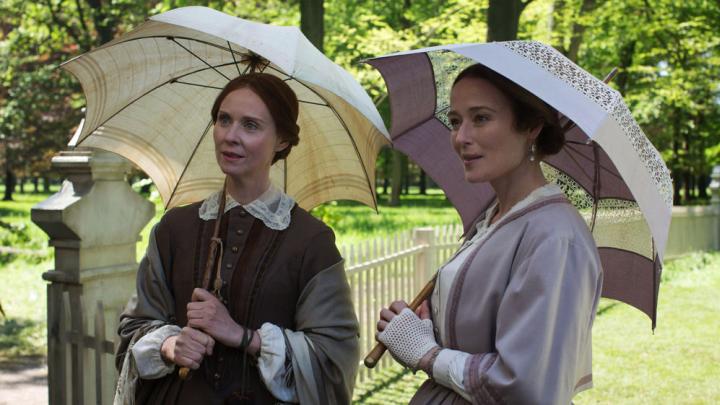Next fall, Houghton Library will publish a gift-book edition of some lesser-known lines by Emily Dickinson: her recipe for black cake, brief on the page but epic in scale. The librarians have twice undertaken making this dessert, which calls for, among other things, two pounds of butter, five of raisins, and 19 eggs. As documented on YouTube, this batter’s not hand-mixed so much as rowed through, or maybe shoveled, before filling a kitchen’s worth of pans and going into the oven for three hours.
Poet James Merrill and Thomas H. Johnson, who edited the three-volume 1955 edition of Dickinson’s poetry, once tried to contact her via Ouija board, hoping to learn of some long-lost caches of her letters in houses across New England. For the librarians faithfully following Dickinson’s words—even hunting down fresh citron and candying it themselves—the cake seems to have been a different kind of communion. They got a sense of her tastes. They conjured up a friendly ghost of her material existence.
A Quiet Passion, a new movie about Dickinson by Terence Davies, is similarly invested in the texture of the poet’s daily life. Baking, in fact, occasions one of the movie’s most slyly perceptive scenes, in which Dickinson is told the result of a bread contest she’d entered. “Second?” she repeats, icily. At a recent screening at the Harvard Film Archive, Davies said, “She liked to play the piano. She gardened. She liked to dance! She looked forward to the Commencement balls. She had a good sense of humor...and I didn’t want her to be somber,” he continued. “There’s nothing worse than biopics where they’re geniuses and they go around and look miserable all the time. They’re tedious!”
But Davies’s portrayal of domestic activity doesn’t try to tame Dickinson’s spiky brilliance. Rather, he simply observes that as the radius of her society shrank, home life took on greater primacy—and his film makes it feel like an intuitive backdrop for the formation of her transcendent verse. (We also come to understand the generally stilted dialogue as a kind of family vernacular—an artificially high decorum that blooms only in temperate, confining conditions.)
As embodied by actress Cynthia Nixon, Dickinson vibrates at a higher frequency than the people around her. She is brittle, vulnerable, witty, and wry. The contradictions that rule her life keep her in a kind of suspended animation: porousness and flinty resolve; rebellion against convention and submission to her father’s will; freedom and limitation. She sometimes acts out in childlike ways—as when she begs the household staff to forgive her snapping at them, or cries to her sister, Vinnie, “How can you go on loving me?”—because she can’t comprehend compromise. At the same time, she is capable of ruthless clarity about herself that others achieve only with hindsight and age. “You have your poetry,” says a friend, trying to console her. “You have a life; I have a routine,” Dickinson responds.
Various incidents eddy on the surface of the film. Her brother, Austin, gets married, and the sisters befriend his new wife, Susan; a dear friend gets married, and is felt to have been lost. The editor of The Springfield Republican improperly punctuates one of Dickinson’s poems upon publication. Her mother dies, and then her father. She chooses to wear white. But the story is in the undercurrents: her struggles with her art and her convictions, and her eventual withdrawal from the world. Insofar as the movie has a plot, it’s seeded in the first scene, of Dickinson as a young student at the Mount Holyoke Female Seminary. Refusing to profess a faith she doesn’t hold, she is scolded for being a “no-hoper.” Her face lights up with joy when her father and siblings arrive to take her home. Shortly after, Davies skips ahead to her adulthood. But the episode hints at how deeply she feels both the stirrings of her conscience and her filial ties. When, decades later, she walks in on her brother having an affair with an Amherst acquaintance, Mabel Loomis Todd, it’s an offense against both. Her fury is almost blinding.
For readers acquainted with the history of Dickinson’s posthumous publication, this drama may seem to presage not just the family conflict that resulted in her papers being split, but the institutional rivalry between the schools that are now their stewards. The portion belonging to Vinnie was purchased from the last surviving Dickinson heir by a Harvard alumnus, who gifted the archive to the University. Houghton’s collection includes her 40 hand-sewn manuscript booklets, or fascicles, curator Leslie Morris told the HFA audience. The library also holds 300 of the 1,000 surviving Dickinson letters, and 1,023 of the 1,789 distinct poems. The other major trove was held by Todd, who was a co-editor of early editions of Dickinson’s verse. Her cache now resides at Amherst College: some 850 poems and fragments, and 350 letters. But in truth, Morris said in a later interview, Emily never met her brother’s mistress in person.
About this and other liberties questioned at the screening, Davies had this inarguable, if unsatisfying, reply. “I was contractually obliged to deliver a film of two hours and no more,” he said cheerfully. His vision of Dickinson’s life was subjective, “and all subjectivity is unfair and partial.” The youngest of 10 children, raised in a Catholic faith he later rejected, Davies was drawn to Dickinson’s religious iconoclasm, her love for her siblings, her joy in their friends. And while his Liverpool youth was far removed from nineteenth-century western Massachusetts, he felt a kinship with what he saw as her parochial upbringing and intense homesickness at school.
Other readers will find other means of connecting with the poet, and the person, whom locals once called “the myth.” Glorious new editions of her verse provide facsimiles of her compositions, as copied onto folded sheets and hand-sewn together, or scrawled onto convenient envelopes. The Emily Dickinson Archive, launched in 2013 as a collaboration among Houghton, Amherst, and other institutions, provides open access to high-resolution images of her manuscripts. Dickinson’s bedroom at the Amherst homestead, restored in 2015 with its wallpaper roses freshly pink, can be rented by the hour for “studio sessions” in which laptops are permitted but the door must always stay open. But where reverence breeds caution, familiarity breeds intimacy. At an after-hours opening of Houghton’s own Dickinson Room, in honor of the screening, a curator stood by to introduce visitors to its objects: the piano (which belonged to the family), the rug (which likely didn’t), the portrait of the Dickinson children. She spoke with casual affection: “This is Emily’s actual desk,” and, “Emily wasn’t a cat person. She loved dogs.”
But the stroke of genius in Davies’s portrait—the one that renders Dickinson real—is in Dickinson’s clarity about the distance between some imagined literary afterlife and her present, lonely obscurity. “Posterity,” she declares, “is as comfortless as God.”








